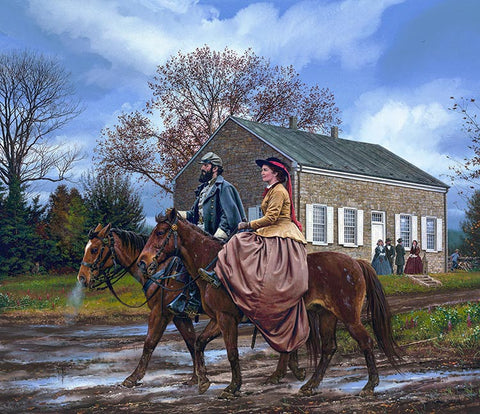RIDE AROUND MCCLELLAN
by John Paul Strain
RIDE AROUND MCCLELLAN
General J.E.B. Stuart & Lt. John S. Mosby
Near Haw’s Shop - Hanover County, VA - June 13, 1862
In March 1862 US General George B. McClellan began his campaign to capture the Confederate Capitol of Richmond. McClellan landed 121,500 men and equipment by boat on the Virginia Peninsula and moved inland. However the Federals were met with strong southern resistance, and after a series of battles their offensive stalled. When commanding Confederate General Joseph E. Johnston was wounded in battle, General
Robert E. Lee took command of the Army of Northern Virginia
On June 10, 1862 General Robert E. Lee met with his cavalry commander, General J.E.B. Stuart concerning how best to defend Richmond. Lee’s plan was to go on the offensive against McClellan’s huge Army of the Potomac.
But to do this General Lee needed detailed information on the enemy’s right flank, and this is where General J.E.B. Stuart and his cavalry came in. One of Stuart’s scouts and staff member Lt. John S. Mosby had reconnoitered the federal right flank and found only a thin screen of cavalry pickets guarding the position. Mosby reported the federal supply depots near the Pamunkey River, and communication lines were completely unprotected. Lee was intrigued and excited about the daring plan for an expedition into the area, and gave his approval.
On the morning of June 12th, General Stuart with 1500 cavalry men, guided by Lt. Mosby, headed in the direction of the Shenandoah Valley to fool any union sympathizers as to their destination. But in the early hours of the 13th the column moved east into enemy territory heading towards the Hanover Court House. One of the cavalry men described the terrain as the sun broke over the horizon. “The roads were surrounded by the fertile fields of waving golden grain.” When the column approached the courthouse a squadron of about 150 federal “Blue Birds” on picket duty were completely caught off guard. In a very few moments they mounted their horses and disappeared in a dense cloud of dust.
Now discovered, the raiders pressed forward rapidly and took the road to Old Church. Near a wooded area near Haw’s Shop, General Stuart and his escort were engaged by Union pickets and cavalry. Stuart gave orders to “Form fours! And charge!” The men in gray pursued the enemy with shouts and yells. A number of the Federals were killed or captured. The chase continued till they reached a small sluggish stream called Totopotomoy Creek.
Stuart’s cavalry continued on to attack a federal supply depot and camp near Old Church. Large supplies of boots, pistols, liquors, and commodities were found and liberated by the southerners. Horses were drafted into Confederate service and supplies left were burned along with federal tents. Telegraph wires were cut along the way as well. General Stuart had achieved his goals on the raid, but now the column was in the heart of the enemy’s country. The expedition had passed within sight of the white tents of General McClellan’s headquarters causing all manner of confusion and fear.
At this point Stuart could not return by the route he had advanced. The alarm had been sounded all over the country, and an overpowering force of Federal infantry, cavalry, and artillery had been rapidly moving to intercept the daring raiders. Stuart was asked by one of his officers, that if they got into a tight place would they surrender? Stuart replied “No,…..one other course was left…..To die game.”
Stuart and his men kept their fast pace as they continued their ride around McClellan’s forces, not stopping to rest. They travelled all night and at dawn arrived at the Chickahominy River, where a barn was hastily torn down to rebuild an old bridge. Now passing through friendly territory Stuart’s raid had become a tremendous success. The three day ride had covered over 150 miles through enemy territory, cutting communication lines, confiscating supplies, weapons, equipment, horses, capturing 180 Federal soldiers, and causing panic and confusion behind Union lines. The whole expedition was highly embarrassing for General George McClellan. Northern newspapers featured the debacle as front page news, and President Lincoln was livid. Southern papers cheered the amazing exploit. Stuart had proved to General Lee, that he was a very capable commander, and was “game” for any challenge.
Archival Paper Giclées
200 S/N Paper Giclées
50 Artist's Proof Paper Giclées
Image Size: 18" x 27 1/2"
Canvas Giclées
100 S/N Studio Canvas Giclées
15 Artist's Proof Studio Canvas Giclées
Image Size 15" x 23"
100 S/N Classic Canvas Giclées
15 Artist's Proof Canvas Canvas Giclées
Image Size 19 3/4" x 30"
30 S/N Executive Canvas Giclées
5 Artist's Proof Executive Canvas Giclées
Image Size 24 1/2" x 37 1/2"






Share this item: